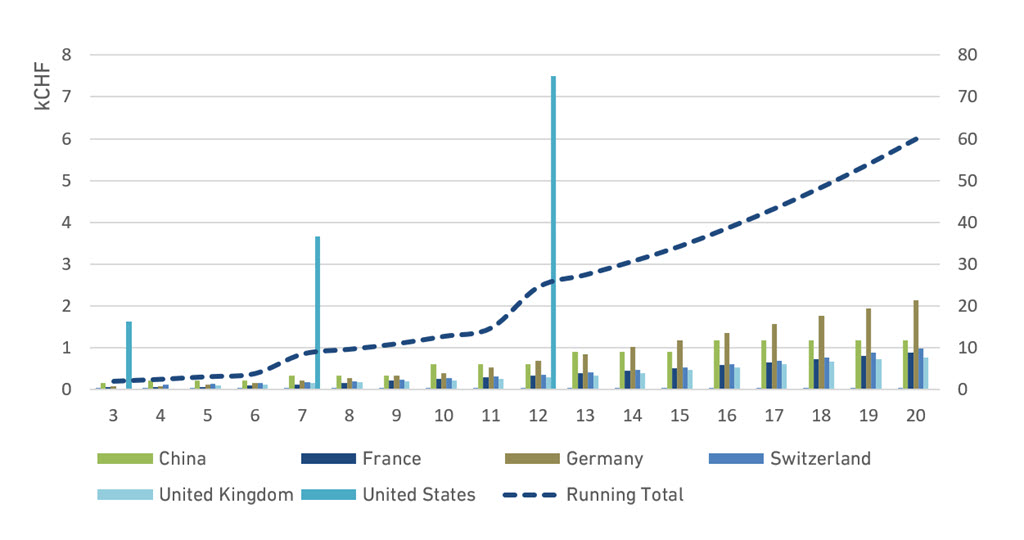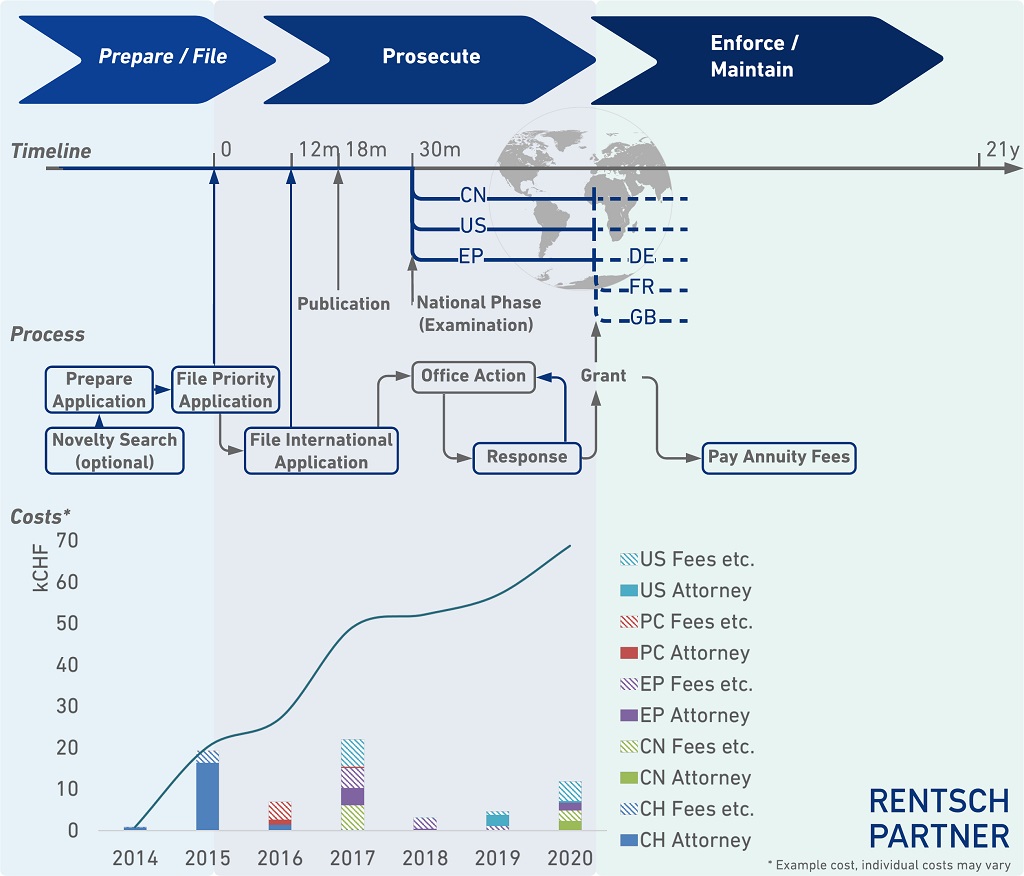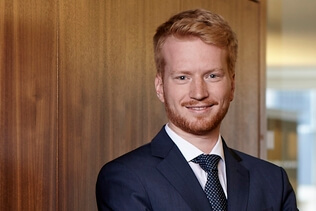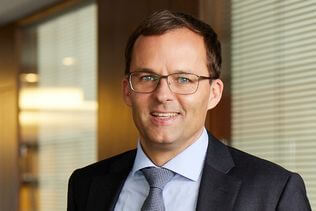Introduction
While patents can provide powerful protection for an invention, the costs involved with obtaining patent protection can be substantial and should therefore not be neglected. In this blog post the expenses which typically have to be expected are summarized on a high level to offer a realistic overview over the lifetime of a patent. It has to be kept in mind, that the provided information is based on our expertise and experience and may therefore be subject to significant variations, depending on the chosen strategy.
What is Patent Protection?
A patent is an Intellectual Property (IP) right granted for an invention. “Invention” in this context relates to a product, a process or an improvement thereof that provides a new way of doing something, or offers a new solution to a technical problem. A patent allows the owner to prevent others from using the protected invention for commercial purposes and to decide who is allowed to produce, sell or import the protected invention in those countries in which a patent is in force. In order to get patent protection, technical information about the invention must be disclosed to the public in a patent application. The protection provided by a patent usually lasts up to 20 years from the filing date of the patent application. After lapse of the patent, the invention becomes public domain and can be used by everyone.
Reasons to apply for a patent…
There are various reasons why you may consider to apply for a patent. Samples thereof are:
- Protection of an idea/technology solving a technical problem, e.g. in form of an improvement which will be implemented in a product.
- Avoidance of conflicts with competitors by claiming protection for the idea/technology.
- Creating assets in form of intellectual property (IP): When selling a company, the intellectual property owned by a company is often one of the most important assets.
- Tax advantages are possible on income generated from IP rights by utilizing the Swiss patent box.
- Marketing for customers and potentially investors alike.
While planning an IP strategy the business impact as well as the costs should be well considered in the budget as patents are usually too expensive when there is no equivalent business. In view of business decisions, this blog post aims to provide a brief overview of the typical costs involved with patenting an invention.
What will not be addressed in this blog post - but is at least equally important and should therefore be considered in each IP strategy - is the aspect of Freedom To Operate (FTO): Independent of filing patent applications to protect an invention, it is necessary to avoid collision between the products/processes brought to the marked and existing IP rights of others.
How much does a patent family cost?
As with most questions, there is no definitive black-or-white answer but the truth resides in various shades of grey. There are various factors determining the cost of a patent, as outlined below.
Generally speaking, the costs involved with obtaining and maintaining a patent can be placed into three stages:
- Stage 1: The costs associated with preparing and filing a patent application.
- Stage 2: The procedure up to grant.
- Stage 3: Annual fees for maintaining patent protection.
Realistic examples for the costs of stages 1 and 2, as well as stage 3 are given at the end of this blog.
Stage 1: Laying the basis for the future - Preparing the patent application
It has to be emphasized that the first application lays the foundation for all subsequent proceedings and ultimately the protection. It should therefore be prepared as thoroughly and complete as possible, keeping in mind that, once the first application has been filed, no alterations (additions or deletions) can be made which affect the content of the application and one is limited to what was originally filed. The reason being, that changes made to the application after it is filed, which affect the original disclosure of the application, usually have an impact on the validity or the application date of the underlying patent application.
The expenses for the initial stage (first year):
Attorney’s Efforts and Official Fees – Total approx. costs 5k-15k CHF which include:
- Discussion of the invention, patent strategy
- Professional Preparation of Application (Claims, Figures, Description) based on information provided by inventor/applicant
- Optional: Prior art search re. patentability of invention (plus 1k-3k CHF)
Comment: A patent application for a mechanical invention usually requires less effort to prepare than, for example, an invention in the fields of biology or chemistry. Additionally, within the respective areas, some inventions are more complex and more comprehensive than others, which typically translates into increased attorney fees as more time is require for different stages of patent prosecution, including drafting of the application. It also matters whether the aim of the application is to lay the base for a whole product family or if only a small improvement shall be protected. Efforts for protecting a new technology are usually significantly higher compared to those which occur when an improvement shall be protected.
Stage 2: Procedure up to grant – Shaping the claims…
The scope of protection is defined by the claims which are the most important part of a patent. Whether a patent with strong and therefore valuable patent claims is obtain or not depends on the results of the examination procedure. Depending on the strategy, the examination procedure typically lasts 3-5 years (it may be accelerated if necessary) and is based on and limited to what was originally filed (see stage 1 above).
During the prosecution of the patent application(s) costs mainly incur from one or several office actions which are dispatched by the patent examiner of the respective patent offices on a national/regional level. In order to achieve the best outcome in view of a strong patent it is necessary to:
- Analyze documents of prior art cited and the arguments brought forward by the examiner in the office action
- Discuss options and define the strategy with the applicant
- Prepare and file a reply to the office action
- If necessary, conduct a telephone interview with the patent examiner(s)
The costs are greatly influenced by the following two factors:
Number of Office Actions/Timing: Usually 1-4 office actions are necessary until the patent application is granted or rejected. More difficult examination procedures require more office actions which lead to greater overall costs. Interesting information regarding the grant rate of a specific US-examiner can be retrieved here. After a reply to an office action has been filed it usually takes several months to more than a year until the next office action is received.
To be on the safe side, an average amount of 1k-3k CHF per office action should be taken into account.
Geographic Scope: The more jurisdictions are selected to seek patent protection in, (i.e. how many countries) the more costs will incur, as the official fees, as well as costs for local representatives and translations etc. must be taken into account.
After grant: It is still possible that after grant additional expenses occur, e.g. in the case that some files an opposition against grant of the patent.
Stage 3: Maintenance - Keeping the patent application / patent alive
After the grant of a patent the protection lasts up to 20 years from the application date of the original patent application. Provisional protection exists from the application date although the patent can be actively enforced only after grant of the respective patent.
In order to keep a patent alive in a country, annually occurring renewal fees have to be paid usually form the third and each subsequent year. These expenses vary depending on country and typically the fees increase during the lifetime of a patent. The total for renewals therefore strongly depends on the geographic scope in which patent protection is to be maintained. If the renewal fees are not timely paid for a specific state, the respective patent right lapses.
The following chart provides an overview of the official fees for five exemplary countries, as well as an estimation of the running total costs for the maintenance of the patents in those five countries (all amounts in kCHF) for the years 3 to 20:

Not covered by this blog are the costs for legal disputes. A patent claiming protection for a technology in a field of active competition can become subject of opposition proceedings after grant of the patent, wherein in most jurisdictions each party covers their attorney fees. Enforcing a patent in order to prevent a competitor from using or selling the protected invention may involve substantial costs as well.
Overview costs for an int. patent application and subsequent national patent applications (rounded figures)
- Up to filing of a priority founding first application: CHF 5-15k CHF for professional preparation and filing fees.
- Before 12 months after filing of a priority founding patent application: Filing of international patent application 5k CHF (assuming no changes are necessary on the priority founding patent application and the content of the priority founding application can be reused for the international application).
- Until 18 months after filing commenting search report / forwarding publication of application: appr. 2k CHF
- 30 months after filing of international application: entry into national phases (for 20 countries appr. 30-50k CHF
- After grant of the patent(s) annual fees need to be paid continuously in order to maintain the patent (see stage 3 above).
Filing an international patent application according to the PCT and then entering into the national phase thereupon delays the decision in which countries to seek patent protection and the related costs by about 1.5 years compared to a direct filing in the desired jurisdictions. This time is often valuable in bringing a product to market and getting customers feedback in order to make a more informed decision about the desired geographic scope of protection.
The figure below shows a typical timeline, the main steps in the process of getting a patent and the costs involved by example of a Swiss startup protecting a medical device for consumers. The costs arise from attorney fees (solid bars) and third party fees like official fees, local representatives etc. (striped areas).

In the example above the cost of preparing and filing the priority founding application in Switzerland (CH, blue) in 2015 are shown. In 2016 the international application (PC, red) was filed 12 months after the Swiss priority application. After 30 months in 2017 the national phases were initiated in China (CN, green), the US (light blue) and in Europe (EP, violet) causing costs in filing fees in each respective country. Afterwards costs occur for handling of the office actions in process up to the grant of the patents.
In case of any question, please feel free to contact the authors of this blog post or any other patent attorney from our firm via our contact form or at This email address is being protected from spambots. You need JavaScript enabled to view it..


